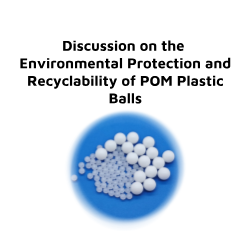
 Home > News
Home > NewsIn recent years, the growing awareness of environmental protection has pushed industries to focus on sustainable materials and manufacturing practices. POM (Polyoxymethylene), also known as acetal or Delrin, is a popular engineering plastic used in various industrial and consumer applications, including the production of plastic balls. POM plastic balls are valued for their excellent mechanical properties, such as high stiffness, dimensional stability, and low friction. However, a critical discussion point today is the environmental impact of POM plastic and its recyclability.

POM plastic balls are widely used in industries like mechanical engineering, automotive, and electronics due to their durability and resistance to wear. Despite these beneficial attributes, the environmental implications of POM production and disposal are important to consider.
Production Impact: The manufacturing process of POM involves the polymerization of formaldehyde or trioxane. This process consumes energy and emits greenhouse gases, although advancements in technology have improved efficiency and reduced emissions. However, POM production is still reliant on fossil fuels, contributing to carbon emissions.
Non-biodegradability: Like many engineering plastics, POM is not biodegradable. If not properly managed, POM waste can contribute to long-term environmental pollution, especially in landfills, where plastic decomposition takes hundreds of years. This characteristic underscores the need for effective recycling strategies to minimize environmental harm.
The recyclability of POM plastic balls offers a solution to the environmental concerns associated with their non-biodegradable nature. While POM is not as easily recycled as some other plastics (such as PET or HDPE), the potential for recycling exists, and it plays an essential role in reducing plastic waste and conserving resources.
Mechanical Recycling: POM plastic balls can undergo mechanical recycling, which involves grinding them into small particles, melting, and reprocessing them into new products. Mechanical recycling helps in reducing the demand for virgin materials and lessens the carbon footprint of producing new plastic products. However, repeated recycling may degrade the material's mechanical properties, limiting the number of times POM can be effectively recycled.
Chemical Recycling: In addition to mechanical recycling, POM plastic is also a candidate for chemical recycling. This advanced process breaks down the plastic into its base chemicals, which can then be purified and repolymerized into new POM material. Chemical recycling preserves the quality of the material and allows for indefinite recycling, making it a highly sustainable option.
Challenges in Recycling POM Plastic Balls: Despite its recyclability, the recycling of POM plastic balls is not without challenges. One key issue is the difficulty in sorting POM from other types of plastics during the recycling process. In mixed plastic waste streams, POM can be difficult to identify, which can hinder efficient recycling. Another issue is contamination, which may affect the quality of recycled POM and limit its reusability in high-performance applications.
To address the environmental impact of POM plastic balls, manufacturers are implementing several sustainability practices aimed at reducing waste and promoting the use of recycled materials.
Use of Recycled POM: Some manufacturers are incorporating recycled POM into their production processes. By using post-industrial and post-consumer recycled POM, companies reduce the need for virgin material and lower the environmental footprint of their products.
Lifecycle Analysis: Companies are conducting lifecycle analyses to better understand the environmental impact of POM plastic balls from production to disposal. This approach helps identify areas for improvement, such as energy consumption, waste reduction, and the adoption of greener production methods.
End-of-Life Solutions: To improve the recyclability of POM products, manufacturers are exploring the design of products with end-of-life considerations in mind. This includes designing POM plastic balls that can be easily disassembled, sorted, and recycled at the end of their use, which promotes a circular economy.
POM plastic balls offer excellent mechanical properties and durability, making them indispensable in many industries. However, environmental protection and recyclability are important considerations as the world shifts towards sustainable practices. While POM is not biodegradable, its recyclability through mechanical and chemical processes presents a viable solution to mitigate its environmental impact. By incorporating recycled POM and focusing on sustainability improvements, the industry can contribute to a more eco-friendly future.
Ultimately, promoting awareness and investment in recycling technologies will be key to enhancing the environmental performance of POM plastic balls. The future of POM lies in balancing its superior engineering properties with responsible production and disposal practices, ensuring its long-term viability in a sustainable economy.
View More(Total0)Comment Lists